Dealing with car damage and collision repairs can be disruptive. One of the first questions vehicle owners often ask after an accident is, “How long until my car is repaired and back on the road?”. The answer, unfortunately, isn’t always straightforward. The duration of car repair can vary significantly depending on a range of factors, from the extent of the damage to the availability of parts and the repair shop’s schedule.
At Car Repair Online, we understand the frustration and uncertainty that comes with needing collision repair. That’s why we’ve created this comprehensive guide to explain what influences car repair time, providing you with a clearer understanding of the process and what to expect. Knowing what to anticipate can help alleviate stress and ensure you’re prepared for the period your vehicle is in the shop.
Decoding Average Car Repair Durations
If you’re wondering about the average car repair time, it’s important to recognize that it’s not a fixed number. Car repair timelines can range from just a few hours for minor cosmetic fixes to several weeks, or even longer, for extensive structural repairs. This broad spectrum highlights the complexity of auto body work and the many variables at play.
To provide a more concrete understanding of typical car repair durations, we’ve compiled a table outlining average repair times for different types of collision damage. Keep in mind these are estimates, and your specific situation may vary.
| Type of Collision Repair | Average Time to Fix |
|---|---|
| Minor Collision Repair | 1-3 days |
| Major Collision Repair | 1 to 3 weeks |
| Paintless Dent Repair | 1-2 days |
| Bumper Repair/Replacement | 1-3 days |
| Fender Repair/Replacement | 1-4 days |
| Door Repair/Replacement | 2-4 days |
| Glass Replacement | 1-2 days |
| Suspension Repair | 2-3 days |
| Frame Straightening | 4 days – 2 weeks |
| Paint Repair (minor) | 2-4 days |
| Paint Repair (major) | 1-2 weeks |
| Airbag Replacement | 2-5 days |
| Engine Repair/Replacement | 1-4 weeks |
| Full Vehicle Restoration | 4-8 weeks or longer |
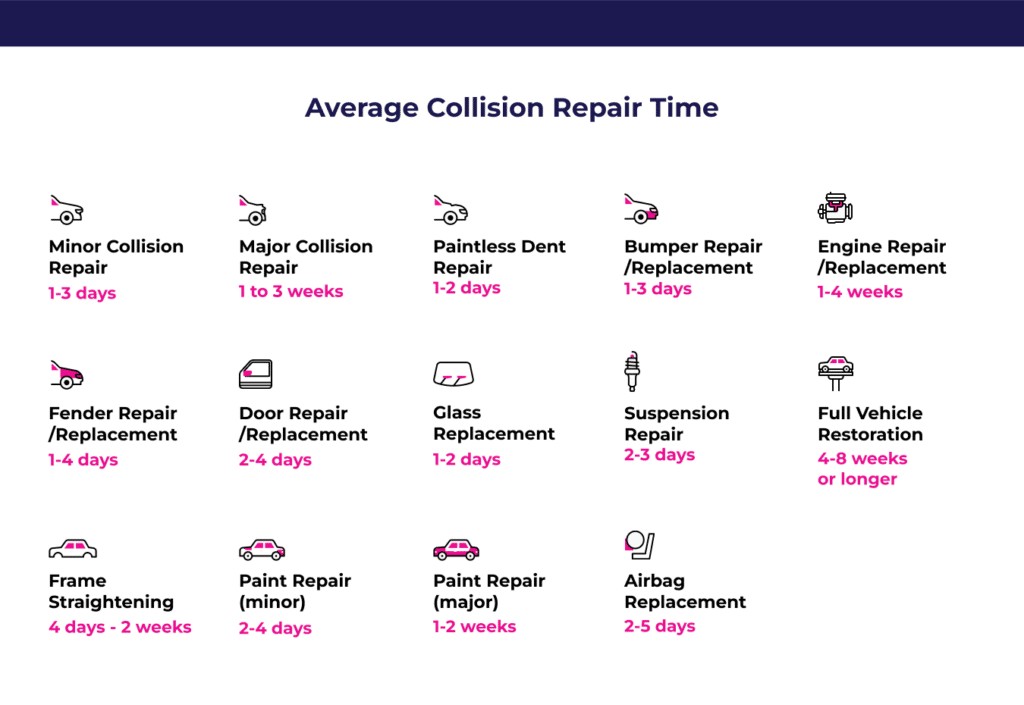

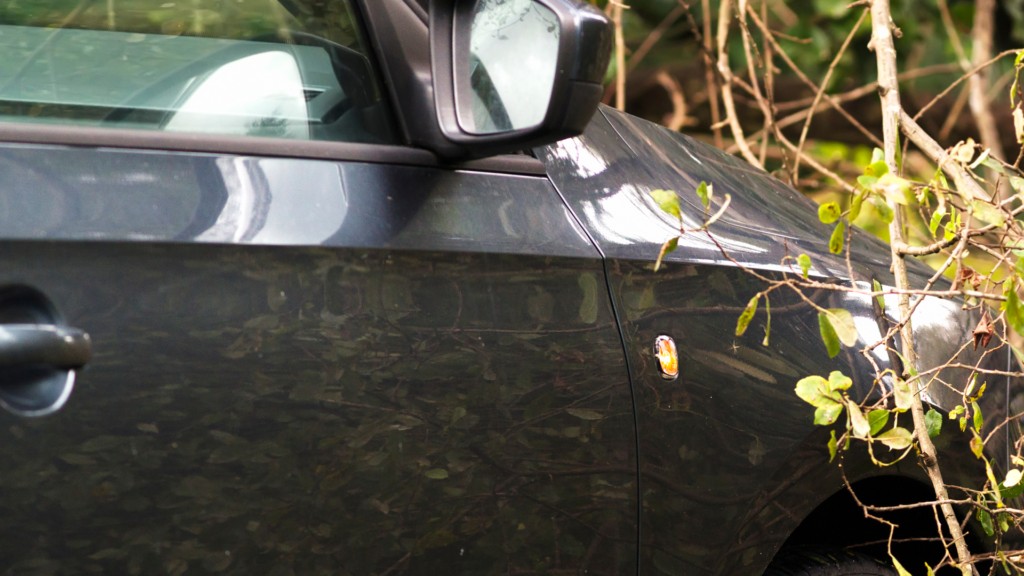
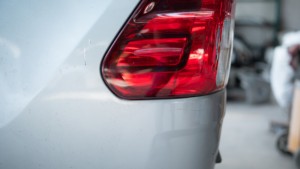
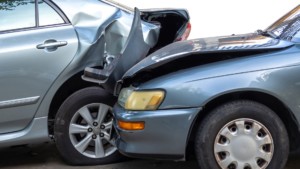
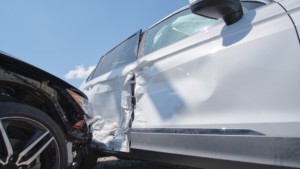
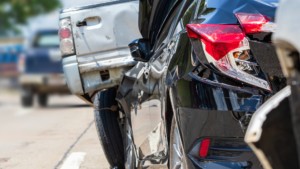
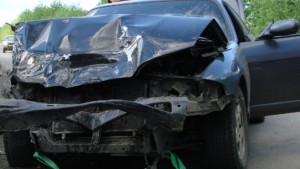


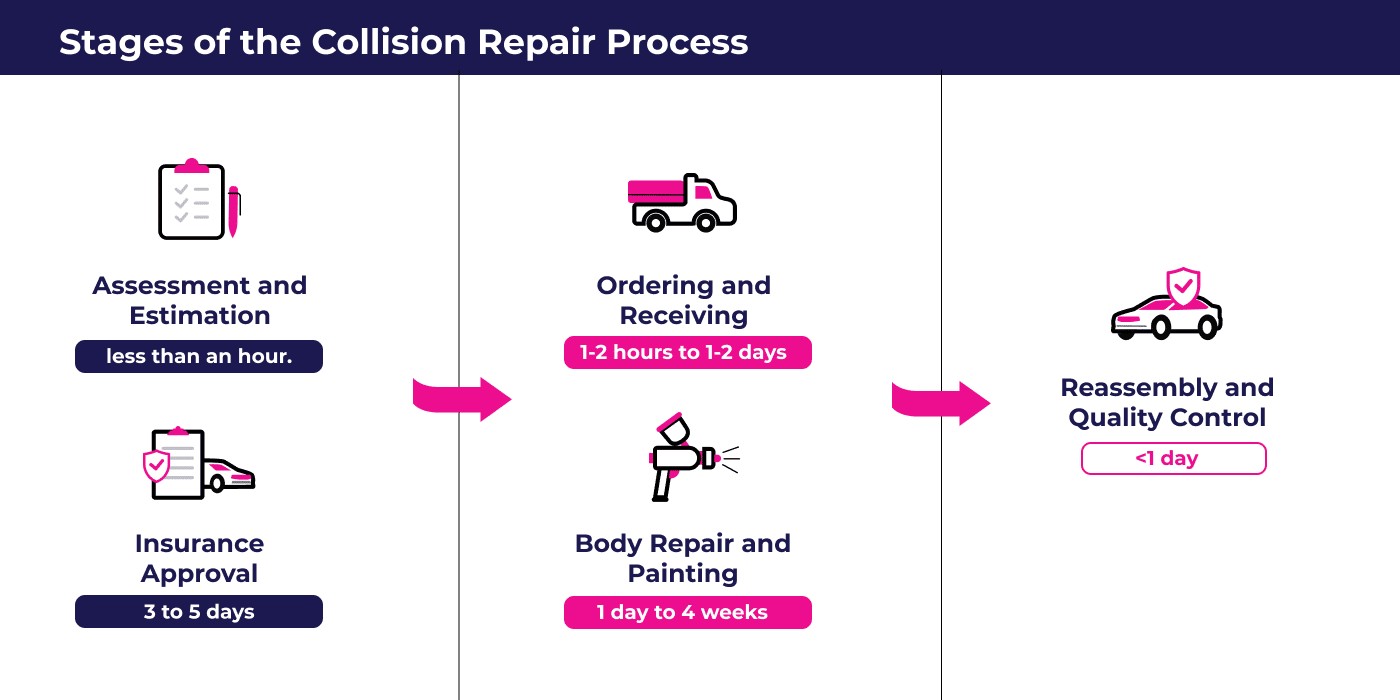
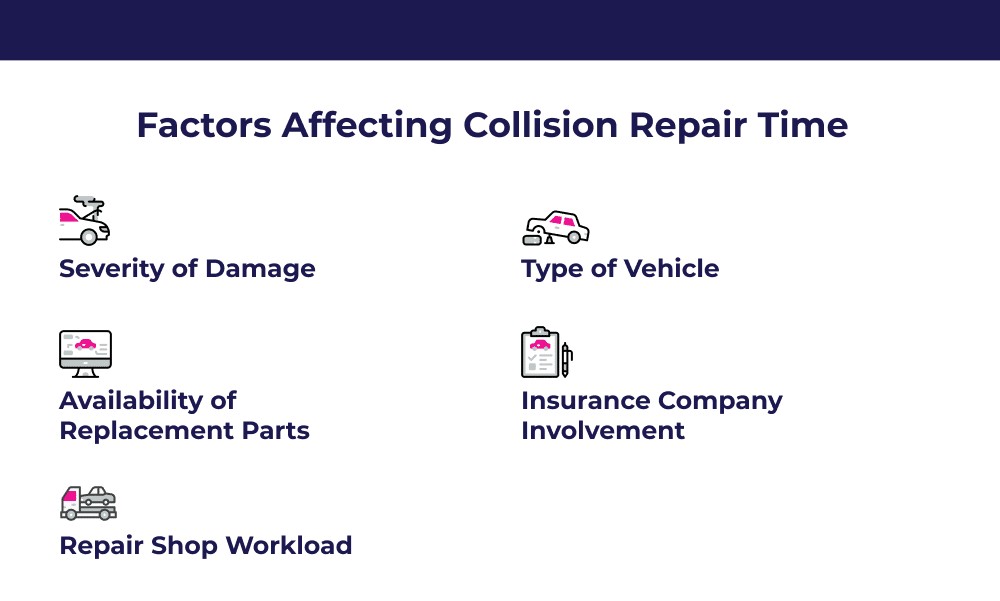
Minor vs. Major Car Repair Time: What’s the Difference?
The distinction between minor and major collision repair is crucial in understanding the expected repair duration. The severity of the damage is a primary determinant of how long your car will be in the repair shop.
Minor Collision Repair: Quick Fixes, Shorter Timeframes
Minor collision repairs are typically characterized by cosmetic damage that doesn’t affect the structural integrity or major systems of your vehicle. These repairs often involve addressing:
- Small dents: Like those from runaway shopping carts or minor parking mishaps.
- Scratches: Surface scratches from branches, road debris, or keying.
- Minor bumper damage: Scuffs, scrapes, or small cracks in the bumper cover.
These types of repairs are generally less labor-intensive. With readily available parts and standard procedures, minor collision repairs can often be completed within 1 to 3 days. In some cases, like paintless dent repair or minor scratch buffing, the work might even be finished within the same day.
Major Collision Repair: Complex Damage, Extended Durations
Major collision repairs, conversely, involve significant damage that impacts the vehicle’s structure, mechanics, or safety systems. These repairs typically address issues arising from:
- Frame damage: Bends, twists, or breaks in the car’s frame.
- Mechanical problems: Damage to the engine, transmission, suspension, or other vital systems.
- Airbag deployment: Replacement of deployed airbags and related sensors.
- Significant body panel damage: Crushed doors, fenders, or quarter panels.
Major collision repairs require specialized equipment, skilled technicians, and potentially longer wait times for parts. As a result, these repairs can take anywhere from 1 to 3 weeks or even longer, depending on the complexity and parts availability.
Severe Collision Damage: Extensive Repairs, Lengthy Timeframes
In the most severe cases, collision damage can be exceptionally extensive, requiring highly specialized and time-consuming repairs. This category includes situations like:
- Extensive frame damage: Major structural damage requiring significant straightening or even frame replacement.
- Hard-to-find parts: For rare or older vehicles, obtaining necessary replacement parts can significantly delay repairs.
- Complex system repairs: Damage affecting multiple vehicle systems (electrical, mechanical, structural).
Severe collision repairs can easily extend beyond 3 weeks, and in some instances, may take months to complete. The priority in these cases is ensuring the vehicle is safely and properly restored, which necessitates a meticulous and potentially lengthy repair process.
Understanding the Stages of Car Collision Repair
To further demystify car repair time, it’s helpful to understand the typical stages involved in the collision repair process. Each stage contributes to the overall timeframe, and potential delays in any stage can impact when you get your car back.
1. Initial Assessment and Estimate: Setting the Stage
The first step is a thorough assessment of the damage. A qualified technician will inspect your vehicle to identify all visible and potential hidden damage. This stage involves:
- Damage evaluation: Determining the extent and type of damage.
- Repair plan: Outlining the necessary repairs and procedures.
- Cost estimate: Calculating the anticipated cost of parts and labor.
- Photo documentation: Taking pictures for insurance and record-keeping.
Timeframe: Generating a comprehensive and accurate estimate can take anywhere from a few hours to a full day, depending on the shop’s processes and the complexity of the damage. Some shops, like StormWise, strive to provide estimates within an hour.
2. Insurance Approval: Navigating the Claim Process
If you’re filing an insurance claim, the repair estimate must be submitted to your insurance company for review and approval. This stage can involve:
- Estimate submission: Sending the repair estimate to the insurance adjuster.
- Review and negotiation: The insurer assesses the estimate, potentially requesting adjustments or clarifications.
- Approval process: The insurance company authorizes the repairs and payment.
Timeframe: Insurance approval can take 3 to 5 business days or sometimes longer, particularly if there are disagreements about the scope or cost of repairs or if the insurance company requires a second estimate.
3. Parts Procurement: Ensuring the Right Components
Once the estimate is approved, the repair shop will order the necessary replacement parts. The time for parts procurement depends on:
- Parts availability: Common parts are usually readily available, while specialized or OEM (Original Equipment Manufacturer) parts may need to be ordered from manufacturers or suppliers.
- Vehicle make and model: Parts for popular vehicles are typically easier to source than those for rare or luxury cars.
- Shipping times: Parts may need to be shipped from warehouses or distant locations.
Timeframe: Parts ordering and receiving can range from a few hours to 1-2 days for common parts. However, for less common or back-ordered parts, this stage can extend to several days or even weeks, significantly impacting the overall repair timeline.
4. Body Repair and Refinishing: Restoring Your Vehicle’s Form
This is the core repair stage where the actual physical work takes place. It includes:
- Bodywork: Repairing dents, straightening panels, and addressing structural damage.
- Panel replacement: Removing and replacing damaged panels like fenders, doors, or bumpers.
- Painting: Matching and applying paint to repaired or replaced panels to ensure a seamless finish.
Timeframe: The body repair and painting phase can vary from 1 day to several weeks, directly correlating with the extent of the damage. Complex frame straightening or multi-stage paint processes will naturally extend this timeframe.
5. Reassembly and Quality Control: The Finishing Touches
After the major repairs are completed, the vehicle undergoes reassembly and quality checks:
- Reassembly: Putting back together trim pieces, moldings, lights, and other components.
- Mechanical checks: Inspecting and testing vehicle systems to ensure proper function.
- Quality inspection: Thoroughly examining the repairs for fit, finish, and overall quality.
- Cleaning and detailing: Washing and cleaning the vehicle before returning it to the owner.
Timeframe: Reassembly and quality control typically take a day or two. This stage is crucial to ensure all systems are working correctly and the repairs meet high standards of quality and safety.
6. Potential for Hidden Damage and Additional Delays
It’s important to be aware that during the repair process, technicians may uncover hidden damage that wasn’t apparent during the initial assessment. This can include damage behind panels, to underlying structures, or to related components. Discovering hidden damage can lead to:
- Revised estimates: Adjustments to the initial repair cost and timeline.
- Additional insurance approvals: If the hidden damage requires further repairs covered by insurance.
- Extended repair time: To address the newly discovered damage and order additional parts if needed.
Additionally, unforeseen circumstances like supply chain disruptions, shop workload fluctuations, or the need for specialized repairs (e.g., frame straightening or wheel alignment) can also contribute to delays.
Key Factors Influencing Car Repair Duration
Several key factors directly influence how long car repair takes. Understanding these factors can provide a more realistic expectation of the repair timeline for your vehicle.
1. Severity of Damage: The Primary Driver
As previously discussed, the severity of the collision damage is the most significant determinant of repair time. Minor scratches and dents will naturally take less time to repair than extensive frame damage or engine repairs. The more complex and widespread the damage, the longer the repair process will be.
Cost Implications: Minor damage repairs can range from $150 to $2,000, while major repairs can escalate to $30,000 or more.
2. Parts Availability: A Potential Bottleneck
The availability of replacement parts is a critical factor that can significantly impact repair time.
- Common Parts: Parts for popular vehicle models are generally readily available, leading to faster repairs.
- Rare or Specialized Parts: Parts for luxury, vintage, or less common vehicles can be harder to source, potentially causing delays of days or weeks.
- OEM vs. Aftermarket: OEM parts may have longer lead times due to manufacturing and distribution, while aftermarket parts might be more readily available but may vary in quality.
Cost Implications: Common parts typically range from $100 to $3,000, while rare or custom parts can exceed $5,000. Backorders and part sourcing difficulties can add both time and expense to the repair process.
3. Vehicle Type: Complexity and Parts Sourcing
The type of vehicle you drive influences both repair costs and timelines.
- Common Vehicles (Toyota, Honda, Ford, Chevrolet): Parts are generally abundant and more affordable. Repairs are often faster and less expensive, typically ranging from $500 to $3,000.
- Luxury/Rare Vehicles (Mercedes-Benz, BMW, Audi, Lexus, Tesla): These vehicles often require specialized parts, technicians, and repair procedures. Repairs can be significantly more expensive, often exceeding $5,000, and take longer due to parts sourcing and specialized labor.
- Newer Vehicles: While potentially technologically advanced, newer vehicles may benefit from better OEM parts availability and warranty coverage, potentially streamlining repairs.
4. Insurance Involvement: Adding a Layer of Process
When an insurance claim is involved, it introduces an additional layer of process that can affect the repair timeline.
- Claim Filing and Approval: The insurance claim process, including estimate review and approval, adds time to the overall repair duration.
- Negotiation and Adjustments: Disagreements or negotiations between the repair shop and insurer can further extend the timeline.
- Direct Repair Programs (DRP): Using a shop within your insurer’s DRP network can sometimes expedite the process, but it’s important to choose a shop that also prioritizes quality.
Cost Implications: Minor repairs under $1,000 are often handled out-of-pocket for speed. Larger insurance claims can range from $1,500 to $5,000 or significantly more, and the claim process itself can add days to weeks to the repair time.
5. Repair Shop Workload: Shop Capacity and Scheduling
The workload of the chosen auto repair shop directly impacts scheduling and turnaround times.
- Shop Busy-ness: A busy shop with a high volume of repairs may have longer wait times for appointments and completion of work.
- Technician Availability: The availability of qualified technicians can also affect scheduling.
- Shop Efficiency: Well-organized and efficient shops can often complete repairs more quickly than less organized ones.
Choosing a Reputable Shop: Selecting a reputable collision repair shop is crucial. These shops typically offer transparent communication, fair pricing, quality workmanship, and may assist with insurance processes. While repair costs can average between $1,500 to $5,000, the shop’s workload and efficiency will influence the actual repair duration.
Conclusion: Patience and Communication are Key
While the question “How long does car repair take?” doesn’t have a single definitive answer, understanding the factors discussed in this guide can help you develop realistic expectations. Car repair times can range from a single day to several weeks, depending on damage severity, parts availability, vehicle type, insurance processes, and the repair shop’s workload.
Patience is essential during the car repair process. Choose a reputable auto body shop, maintain open communication with them, and understand that unforeseen delays can sometimes occur. A good repair shop will keep you informed throughout the process and strive to return your vehicle to you as quickly and safely as possible, without compromising quality.
Average Collision Repair Time FAQs
What are my transportation options while my car is being repaired?
Finding transportation while your car is in the shop can be challenging. Explore these options:
- Rental Car Coverage: Check your insurance policy to see if it includes rental car reimbursement.
- Repair Shop Loaner Vehicles: Some repair shops offer loaner vehicles to customers.
- Public Transportation, Ridesharing, or Carpooling: Consider these alternatives depending on your needs and location.
- Courtesy Pick-up and Drop-off: Some shops, like StormWise, offer free pick-up and drop-off services.
Is there a warranty on automotive repairs?
Yes, reputable auto body shops typically offer warranties on their repair work. For example, StormWise provides a lifetime warranty on auto body and accident repair services, demonstrating confidence in their workmanship. Always inquire about warranty coverage before choosing a repair shop.
Are front-end or rear-end collision repairs faster?
Generally, rear-end collision repairs are often quicker and less costly than front-end repairs. The front of a vehicle houses more complex components, including the engine, radiator, grill, and headlights, leading to potentially more extensive damage and repair work in front-end collisions.
When is a car considered a total loss?
A car is typically deemed a total loss when the cost of repairs exceeds its market value or a certain percentage of its value (often around 70-75%). In such cases, the insurance company may declare the vehicle totaled and offer a settlement based on its pre-accident value, rather than covering the full repair costs.
What should I do if my car repair is taking longer than estimated?
If your car repair is significantly exceeding the initial estimate, take these steps:
- Communicate with the Repair Shop: Contact the shop to understand the reason for the delay. It could be due to hidden damage, parts delays, insurance issues, or other unforeseen factors.
- Contact Your Insurance Company: If the delay seems unreasonable or is related to insurance claim issues, contact your insurance adjuster for assistance.
- Consider a Second Opinion (Cautiously): While you can consider taking your car to another shop, be aware that switching shops mid-repair can complicate the process, especially with insurance claims and parts orders already in progress. It’s usually best to try to resolve the issue with the current repair shop first.
How much does collision repair typically cost?
Collision repair costs are highly variable and depend on numerous factors, including the extent of damage, vehicle type, parts needed, and labor rates. Average collision repair costs can range from a few hundred dollars for minor repairs to thousands or even tens of thousands of dollars for major damage. Obtaining a free, detailed estimate from a reputable repair shop is the best way to determine the potential cost for your specific situation.


